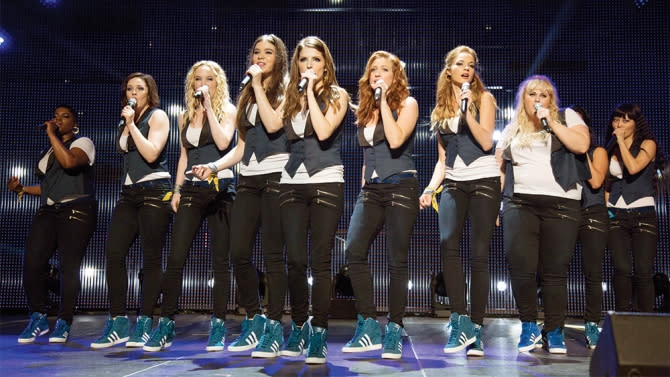Female-Driven Movies Make Money, So Why Aren’t More Being Made?

It’s good business to cast strong women in lead movie roles. Last summer’s opening weekend was a master class on femi-nomics when “Mad Max: Fury Road” and “Pitch Perfect 2” faced off on May 15 — and both films came out ahead.
“Mad Max: Fury Road,” directed by George Miller, starred Charlize Theron as Imperator Furiosa, a rebel opposite Tom Hardy’s Max. No distressed damsel, the character with her own story arc was so tough the choice ignited a backlash that the franchise had gone fanatically feminist. As for “Pitch Perfect 2,” the sequel directed by co-star Elizabeth Banks featured Anna Kendrick, Rebel Wilson and Hailee Steinfeld in a femme-friendly musical comedy.
By the numbers, “Mad Max” cost an estimated $150 million to make. Opening weekend reaped $44 million, with worldwide grosses at $375 million and $153 domestically. Meanwhile, “Pitch Perfect 2” cost an estimated $29 million to make, opened to a $70 million weekend, grossed $285 million worldwide and $183 million domestic. Both films had strong female stars but represented very different genres — and the more female-focused of the two had the better return on investment.
More recently, Emily Blunt proved her box office chops in “Sicario,” in which she stars as an FBI agent who gets a crash course in the drug war, with Josh Brolin and Benicio Del Toro as her dubious mentors. Lionsgate Entertainment opened the $30 million thriller on Sept. 18 in platform release in six venues with a whopping $65,000 per-theater average.
SONG And DANCE: “Pitch Perfect 2” grossed $285 million worldwide, setting the stage for another sequel and proving that female stars can open a movie. |
“The numbers speak for themselves. Period. Worldwide grosses for ‘Pitch Perfect 2’ and ‘Cinderella’ were over $800 million. Clearly women aren’t the only ones going to see these movies,” says Academy member Peggy Rajski, associate arts professor/head of producing, NYU Graduate Film Program.
Looking back in 2015, whether we love or love-to-hate “Fifty Shades of Grey,” the female-directed (Sam Taylor-Johnson), female-led (Dakota Johnson) literary adaptation of the bondage bestseller had a benchmark year. On an estimated $40 million budget, the movie grabbed a worldwide gross of $570 million, with a $94 million opening weekend.
“Fifty Shades of Grey” is a sexy potboiler that could not be more different from “Mad Max,” “Pitch Perfect 2,” “Cinderella” or “Sicario.” In short, the house of female-driven cinema has many, many rooms — most of them as yet unexplored. Meanwhile, two novel-based, female-driven sequels are already in development: “Fifty Shades Darker” is in the script stage and slated for 2017, while “Fifty Shades Freed” has been announced for a 2018 release.
The massive success of “Fifty Shades of Grey” reflects the way in which the movie industry has put bias before good business practices. The book industry has long-known that women are among their most avid readers with the household purchase power behind them. It’s not news that the “Twilight Saga” was an established literary franchise long before it made Kristen Stewart famous and, in four films, grossed over a billion dollars.
“The Hunger Games” trilogy, stretched to four movies, made Jennifer Lawrence a major star by keeping true to the novels’ winning female-driven recipe. With the final installment, “The Hunger Games: Mockingjay — Part 2” opening on Nov. 20 in time for the Thanksgiving sweep, the franchise has grossed Lionsgate $2.2 billion so far.
DOLLARS & SENSE |
Female-driven pics score at the B.O. |
$70m “Pitch Perfect 2” opening weekend |
$2.2b Culmulative B.O., ‘Hunger Games” pics |
$94m “Fifty Shades of Grey” opening weekend |
Beyond the event movies, female-driven comedies are on the rise. Both Melissa McCarthy’s “Spy” (worldwide $236 million) and Amy Schumer’s “Trainwreck” (worldwide $138 million) were R-rated summer hits. Amy Poehler and Tina Fey hope to capture Christmas with the upcoming “Sisters.”
It comes as no surprise that given the opportunity, female-driven films connect with audiences. Rajski raises the question: “Over half the world’s population is female. Why wouldn’t you target that audience more aggressively?”
The gender gap is bad business: as Oscar winner Meryl Streep pointed out in 2012: “Why? Why? Why? Don’t they want the money?” Her question echoes three years later, begging for a shareholders’ revolt. Female-driven movies make money. In an era when movies are beset by competition from quality television, video games and alternative entertainment, the industry can’t afford to be biased.
Related stories
Oscar Race Sees Flood of Female-Driven Pics
'Mad Max' Sequel Still Tops Disc Sales Charts
Summer Movie Piracy Rises: 'Mad Max: Fury Road' Tops 2015 Downloads
Get more from Variety and Variety411: Follow us on Twitter, Facebook, Newsletter

